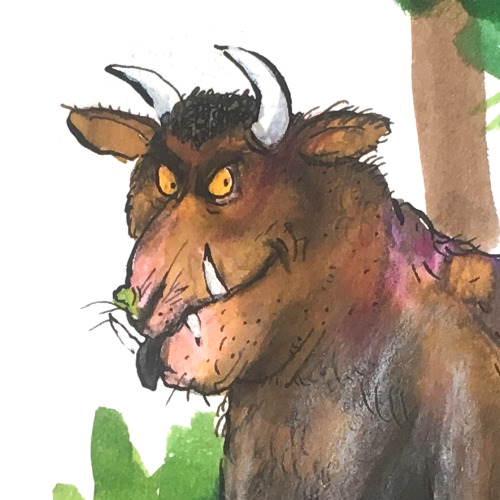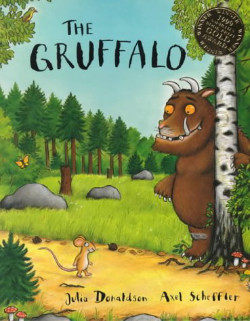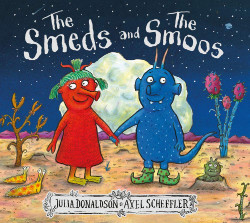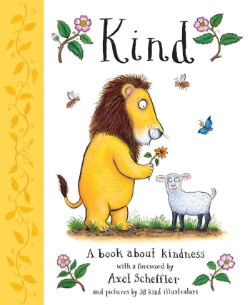< Back to posts
Axel Scheffler
Germany / United Kingdom

Axel Scheffler has illustrated some of the world’s most well-loved children’s books. ‘The Gruffalo’ is considered one of the most successful picturebooks of all time, having been translated into 86 languages/dialects and sold over 14 million copies. Axel was born in Hamburg, and has lived and worked in London since the 1980s.
In this post, Axel takes us on a journey through his art studio and career. As well as sharing wonderful development work from some of his much-loved picturebooks, he shows us unseen sketchbook pages, early illustration commissions, etchings he made as a student, and his recent work to educate children about the coronavirus.
Axel: I’m not really sure how many books I’ve illustrated in the 30+ years that I’ve been working. Over 150. I mostly work for the UK market, but occasionally I do books with German publishers. Not picturebooks though, so nothing that collides with the co-edition market.
Each of the boxes you see here contains one of my books: the sketches, illustrations, dummies, alternate versions of covers, everything.
I organised these boxes with Liz, my assistant, to have all the main books there so we can find things for exhibitions. There’s still lots of drawings in these boxes which aren’t sorted yet. Liz is such a great help, but it’s very difficult for me to keep on top of everything. I think I would probably need two Lizes, or perhaps three.
So yes, I don’t really know where to begin… I’ve got endless sketchbooks and little drawings on paper. I’ve got some really old sketchbooks I could show you.
Shall we start with The Gruffalo?
My early sketches of the Gruffalo were thought by my editor to be too scary for small children. So I had to make him a bit rounder and more ‘cuddly’. Initially, I‘d also thought that all the animals would be wearing clothes, as they often do in picturebooks. But Julia had different ideas, and to be honest I was relieved. How would I have dressed the snake?
Here’s some spreads from the dummy…
I tried a lot of alternate covers for this book; I think there were twelve in total. There’s some where the Gruffalo doesn’t even feature on the cover.
My latest book with Julia is called ‘The Smeds and The Smoos’. It was quite nice to work on because it’s so different from the other books we’ve done together. The text is a bit like a mixture between Dr Seuss and Lewis Carol; it has this nonsense element. But it’s basically Romeo and Juliet in outer space.
It’s an alien story, so I didn’t have to draw any rabbits or squirrels for a change, and I could invent more. I had more freedom. But like always, I got bored with drawing the same characters over and over again. But that’s picturebooks.
There was quite a lot of development work in the case of this book. But when it’s a story about a fox or a squirrel, I don’t do this kind of stuff. Over the years, it’s become much quicker and easier working on my books. I do far less research than I used to. Now I generally just do a quick pencil sketch then go straight to artwork.
Sometimes I have to start again because things go wrong though. This was a finished piece that was abandoned. I think I suddenly thought that the rocket was far too big or something. I do that; I work on something for ages, and then I suddenly look at it from a distance and realise that something needs redoing.
Did you spot the little Gruffalo in this picture? Since ‘The Snail and the Whale’, I’ve hidden a Gruffalo in each of my books with Julia (not ‘The Ugly Five’ though).
For almost all of the books Julia and I have done together, our editor has been Alison Green. We’re an old established team. And I’ve always worked with the publisher Kate Wilson; I followed her from Macmillan to Scholastic, and then to Nosy Crow. Julia moved from Macmillan to Scholastic, and decided to stay there. So Julia and I have some of our joint titles with Macmillan and some with Scholastic. Julia does books with other illustrators for Macmillan, and I illustrate other books for Nosy Crow.
People often ask me which of the books I’ve done with Julia is my favourite. It’s quite hard to choose, but I enjoyed working on ‘The Smartest Giant in Town’. I liked the way I could do a crazy world with animals, giants, fairytale characters, everything mixed together without anyone caring or questioning it. I’ll show you a few things from the box…
For this book, the cover was changed at the last minute. The original design had the title written on a poster stuck on a brick wall, but the sales people said they wanted a landscape, so I did another one. Years later, they used the original design for a new paperback edition, so it wasn’t completely wasted in the end.
I mentioned my endless sketchbooks earlier. I’ll show you a few of them. This was mainly me playing around without thinking about what I was doing; it wasn’t a conscious thing.
I haven’t looked at these sketchbooks for ages. It was such a long time ago. I don’t work in sketchbooks like this anymore, and I no longer doodle. But for fun, I make illustrated envelopes for friends.
I often think about doing a book with just pictures, but I’m always too busy doing other things. Posthumously, perhaps there will be time to do this. I’d also love to experiment and be more spontaneous; it’s been my dream for decades to do something completely different. But when I receive a book project, I always feel under pressure to finish it, and I’m always late with everything, so I end up doing it the way I’ve always done it.
This is my drawing table, which is and always has been too small and too messy. I think I have to accept it will always be this way.
I use Saunders Waterford paper for my illustrations. It’s funny how we all have our special paper. My rough sketches are often quite small, so I have them blown up to the correct size. Then I trace the sketches on a lightbox onto my watercolour paper. After that, I draw the outlines in black ink with a dip pen. I colour everything with Ecoline inks using brushes, and then coloured pencils on top of it (I use Faber Polychromos and Prismacolour crayons). I might then need to redraw some of the black lines, or use some white gouache for highlights.
I studied History of Art in Hamburg, but left before graduating. I realised this wasn’t what I was good at; I’m not an academic.
Then I had to do my alternative service as conscientious objector. Sixteen months. There was still conscription then; that’s how old I am. I worked with mentally ill people in their homes. It was during this time that I had a friend studying ceramics at Bath Academy of Art in England. I went to visit her. I really didn’t know what else to do, so I thought maybe I could move to Bath and go to the art school. So this is what I did. The course was Visual Communications, so it was design, printmaking, photography, all that stuff. But I realised I only wanted to do illustration.
I’d gone to art college hoping to learn something. I don’t think that necessarily happened, but drawing intensively for three years was, I think, what I had needed to do. I don’t remember actually finishing any projects though.
Here’s some drawings from my student sketchbooks. I did lots of observational drawing back then, which I don’t anymore. I did it then because they told us to. I’m an obedient person!
While I was a student, I did an exchange in New York: Cooper Union Art College for three months. These drawings are of Jewish immigrants, meeting for coffee. It was 1984, so many of them were still alive; refugees from Germany or Austria. I heard them speaking German, so that’s how I knew.
Sketchbooks are such a good way of memorising things. Nobody really knows about these sketchbooks; I used to take them to interviews, but they’ve been hidden away for years.
After I graduated, I moved to London and took my portfolio around. My art teacher had suggested I should do this to get work, so that’s what I did. In those days, you had to ring them and ask to come around. I got two commissions straight away, and it’s been busy ever since, really. I’ve always had something to do.
Here’s some of my early commissions. Starting from 1985, I guess. Very pointy noses…
I did so much of this kind of work. It was a good way of earning money quickly. Occasionally, I still do editorial. I did some Brexit drawings for the remain campaign. Sadly, it didn’t help. Maybe I wrecked everything!
I’ll say a few words about the KIND book… 38 wonderful artists donated a picture to illustrate some of the many ways children can be kind. Such as sharing their toys or helping people from other countries to feel welcome.
One pound from each book sold goes to the Three Peas charity, which supports refugees from war-torn countries. It’s been a big success so far, and Three Peas has received a lot of money from sales in the UK and co-editions.
I’d quite like to do the UNKIND book next! I think illustrators would probably enjoy that, but I don’t imagine it would sell very well.
And now for something completely different! Some etchings I made when I was a student.
People often ask me which illustrators I’m inspired by. I don’t seek any direct influence on my work, but I’ve always said that Tomi Ungerer had the greatest influence on my approach to illustration. Although his style is quite different to mine, this humour and wackiness is something that has always appealed to me. And the details.
William Steig is someone I got into later, when I was already illustrating. And Edward Gorey of course. And Saul Steinberg. I think the Czech artist Jiří Šalamoun is wonderful. And I like Eva Lindström from Sweden a lot. She’s so great.
Okay, to finish with I’ll talk about the coronavirus work I’ve been doing…
I asked myself what I could do as a children’s illustrator to inform, as well as entertain, my readers here and abroad about the coronavirus. So I was glad when Nosy Crow asked me to illustrate a book on the subject. I think it’s extremely important for children and families to have access to reliable information in this unprecedented crisis.
You can download the free digital book in English here, and in over 60 other languages here.
I also wanted to do something light-hearted to cheer people up, and I thought, “What if I imagine some of our characters in corona situations?” Julia liked the idea and wrote rhymes for the new scenes. This was really more about entertainment than serious information.
Artwork and verse © Axel Scheffler and Julia Donaldson 2020. Based on characters from ‘The Gruffalo’s Child’ (2004), ‘Charlie Cook’s Favourite Book’ (2005), ‘The Smartest Giant in Town’ (2002), and ‘The Gruffalo’ (1999) — © Macmillan Children’s Books.
And here’s one more thing: my ‘letter from lockdown’. On The Children’s Bookshow website, you’ll find lockdown letters from lots of other wonderful authors and illustrators.
Illustrations © Axel Scheffler. Post edited by dPICTUS.
The Gruffalo
Julia Donaldson & Axel Scheffler
Macmillan Children’s Books, UK, 1999
‘A mouse took a stroll through the deep dark wood. A fox saw the mouse and the mouse looked good.’
Walk further into the deep dark wood, and discover what happens when a quick-witted mouse comes face to face with an owl, a snake… and a hungry Gruffalo!
‘The Gruffalo’ has become a bestselling phenomenon across the world. This award-winning rhyming story of a mouse and a monster is now a modern classic, and will enchant children for years to come.
- PUBLISHED IN THE FOLLOWING LANGUAGES & DIALECTS
- Afrikaans
- Albanian
- Arabic
- Australian
- Azerbaijani
- Basque
- Belarusian
- Bengali
- Breton
- Bulgaria
- Catalan
- Chinese (Simplified)
- Chinese (Traditional)
- Corsu
- Croatian
- Czech
- Danish
- Doric
- Dundonian
- Dutch
- English
- Esperanto
- Estonian
- Faroese
- Farsi
- Finnish
- French
- Frisian
- Gaelic
- Galician
- Georgian
- German
- Glasgow Scots
- Greek
- Guernésiais
- Hebrew
- Hindi
- Hungarian
- Iceland
- Indonesian
- Irish
- Italian
- Jèrriais
- Kazakh
- Kölsch
- Korean
- Latin
- Latvian
- Lithuanian
- Low German
- Lowland Scots
- Luxembourgish
- Macedonian
- Maltese
- Manx Gaelic
- Maori
- Marathi
- Mexican Spanish
- Mongolian
- Norwegian
- Orcadian Scots
- Polish
- Portuguese
- Portuguese (Brazil)
- Romanian
- Russian
- Sami
- Schwabisch
- Serbian
- Sesotho
- Setswana
- Shetland Scots
- Slovakian
- Slovenian
- Spanish
- Swedish
- Swiss German
- Tamil
- Thai
- Turkish
- Ukrainian
- US English
- Vietnamese
- Welsh
- Xhosa
- Zulu
The Smeds and The Smoos
Julia Donaldson & Axel Scheffler
Alison Green Books, UK, 2019
The Smeds (who are red) never mix with the Smoos (who are blue). So when a young Smed and Smoo fall in love, their families disapprove.
But peace is restored and love conquers all in this happiest of love stories. There’s even a gorgeous purple baby to celebrate!
- PUBLISHED IN THE FOLLOWING LANGUAGES
- Afrikaans
- Catalan
- Croatian
- Dutch
- English
- Finnish
- French
- German
- Hebrew
- Hungarian
- Italian
- Korean
- Luxenbourghish
- Polish
- Russian
- Slovenian
- Spanish
- Swedish
- Turkish
- Ukrainian
Kind
Alison Green, Axel Scheffler & 38 illustrators
Alison Green Books, UK, 2019
Imagine a world where everyone is kind; how can we make that come true? With gorgeous pictures by a host of top illustrators, KIND is a timely, inspiring picturebook about the many ways children can be kind, from sharing their toys and games, to helping those from other countries feel welcome.
One pound from the sale of each printed copy will go to the Three Peas charity, which gives vital help to refugees from war-torn countries.
- PUBLISHED IN THE FOLLOWING LANGUAGES
- Bulgarian
- Catalan
- Chinese (Simplified)
- Chinese (Traditional)
- English
- French
- German
- Greek
- Hebrew
- Italian
- Korean
- Netherlands
- Portuguese (Brazil)
- Romanian
- Spanish
- Swedish
- Turkish
- Vietnamese









































































